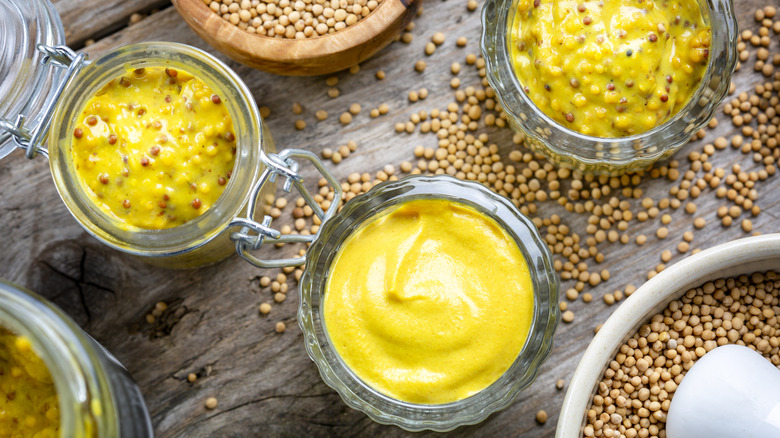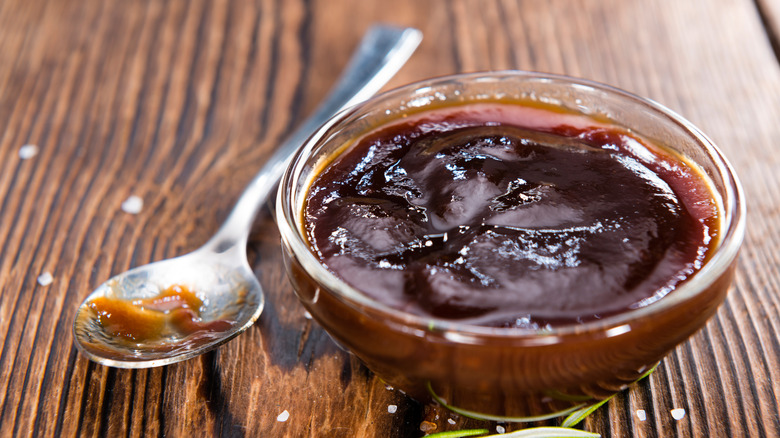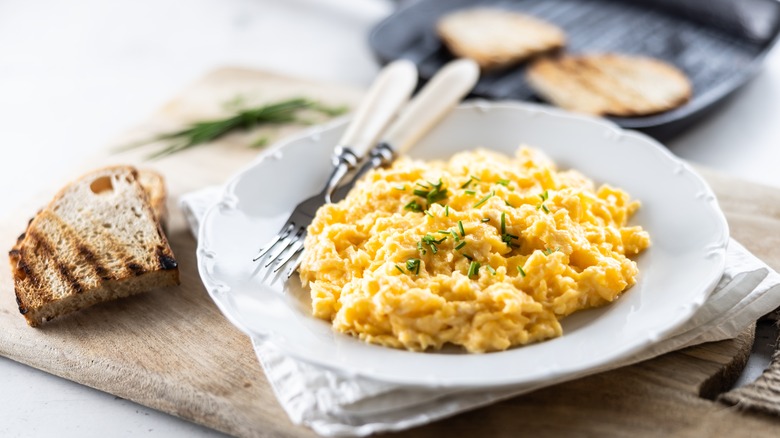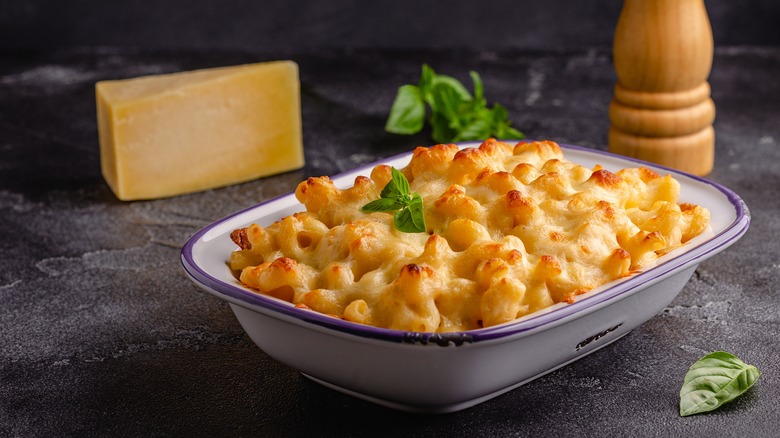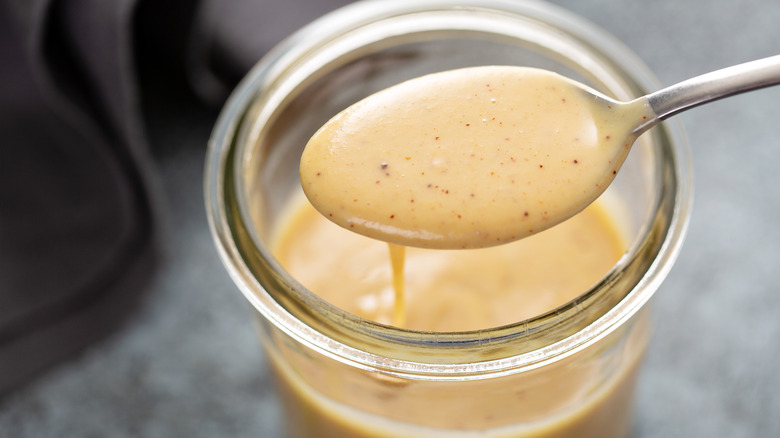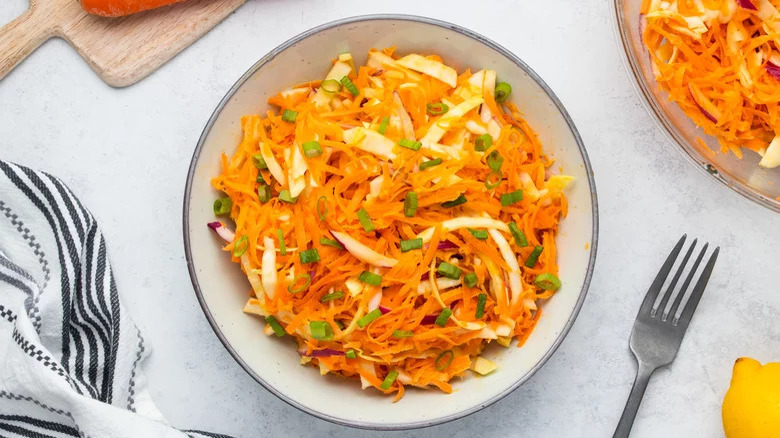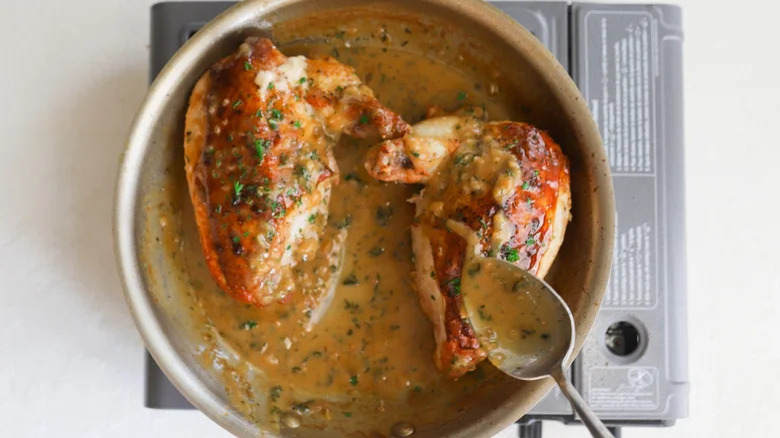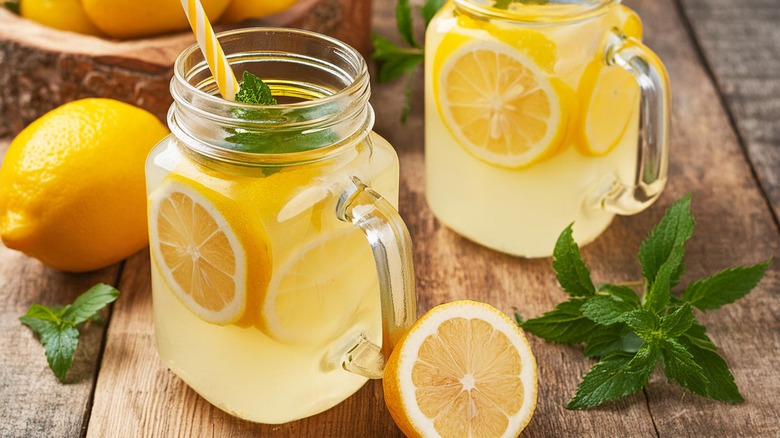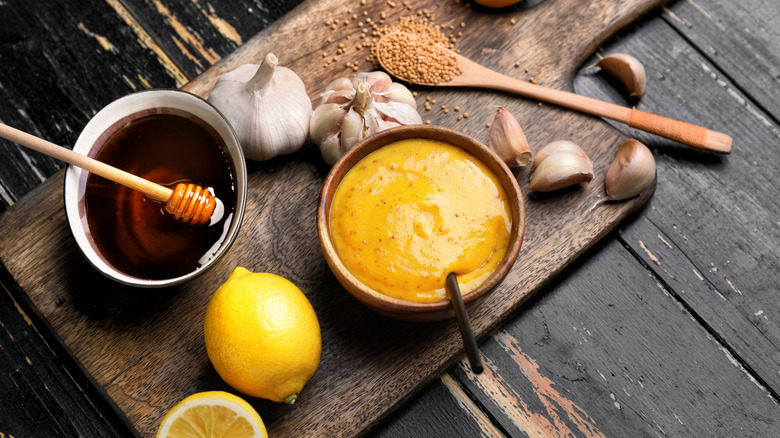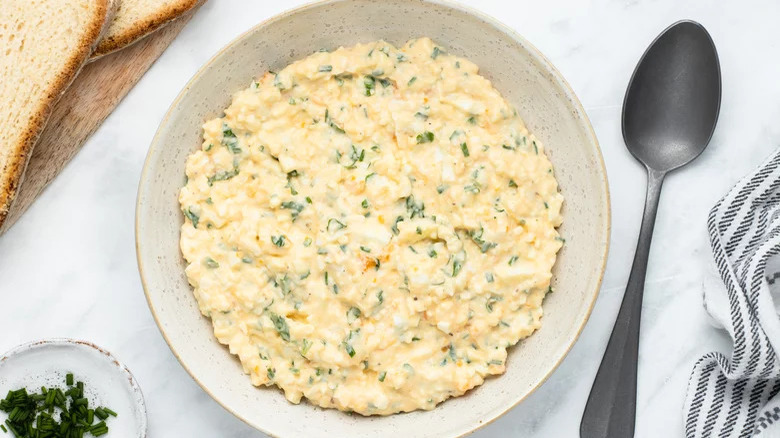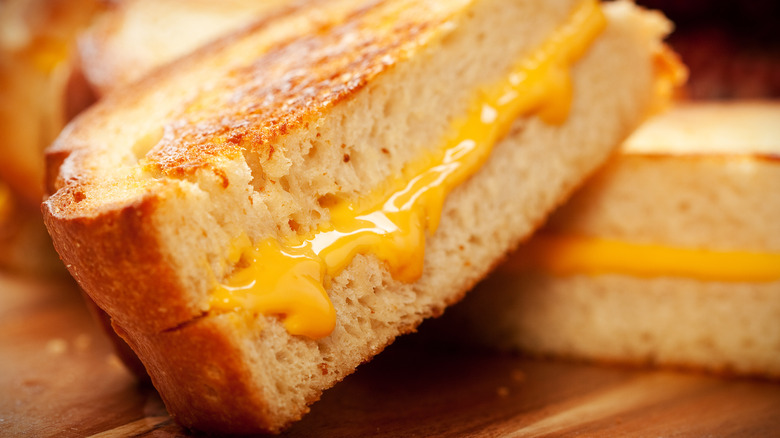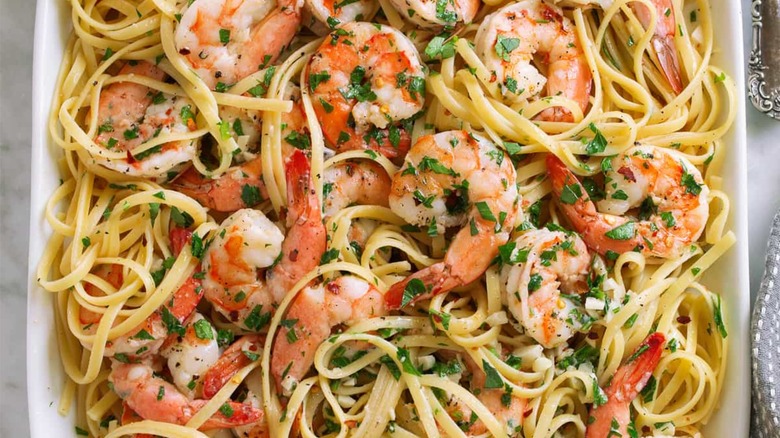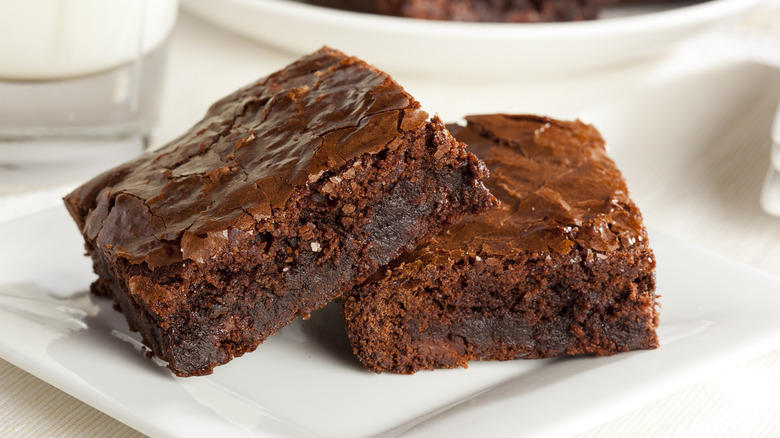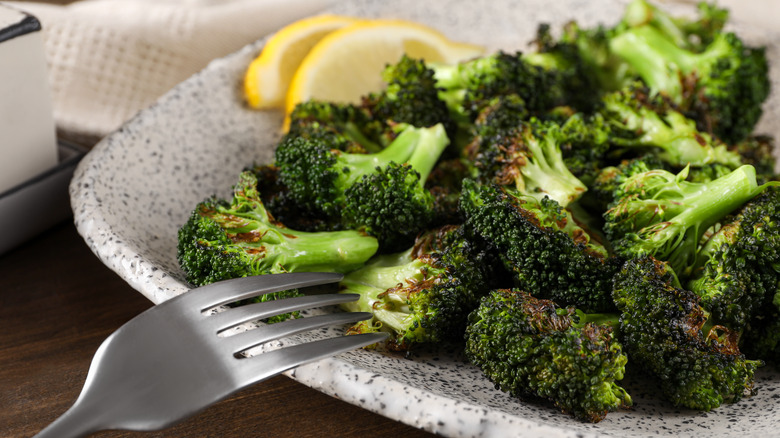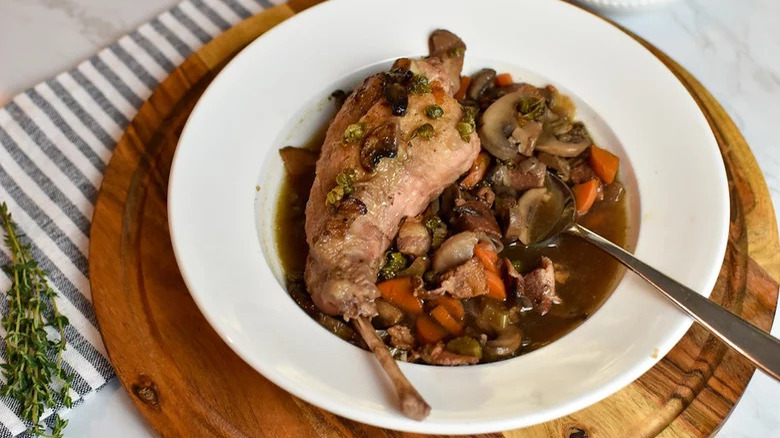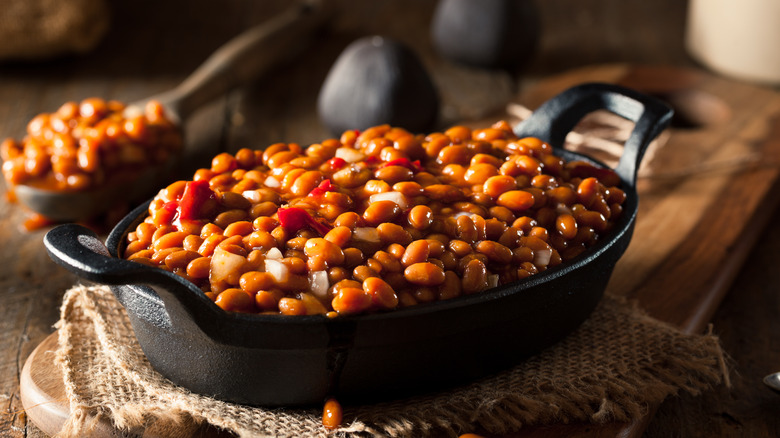15 Ways To Use Up Leftover Mustard
Mustard is a treasured condiment found in many homes. While it's traditionally spread on sandwiches, squeezed atop hot dogs, or used as a dip, there's countless other interesting ways to make use of leftover mustard — you know, that last bit at the bottom of the container. In fact, with just a single tablespoon of mustard (or less), you can freshen up numerous meals, snacks, and sauces.
When you're not quite ready to get rid of the bottle or jar in your fridge, we've gathered some potential options for you to consider before throwing away that leftover mustard. Whether it's a classic yellow, spicy brown, or Dijon variety, the following recipes and concepts can work with any number of popular types of mustard – so feel free to experiment. If you're looking to utilize the last of your condiment rather than open a new container, here are 15 ways to use up leftover mustard.
Add any leftover mustard to BBQ sauce
BBQ sauce has an enticing range of flavors thanks to its ingredients. There's sweetness from sugar (and often ketchup), a bit of tang from white wine vinegar, an umami kick of Worcestershire sauce, and smokiness from paprika (among other ingredients). When you want to amp things up even more — while simultaneously using your leftover mustard – give Dijon or whole grain mustard a shot in your BBQ sauce. This adds a potency as well as a bit of texture to an otherwise smooth sauce.
Both of these mustards are a tad spicy, which can be a welcome addition to BBQ sauce. You can also opt for a standard yellow mustard if you prefer, which provides a milder flavor while transforming the color of your sauce. It might look different than your standard BBQ condiment, but it'll be tasty and dynamic. Simply add a squeeze or scoop of mustard into the sauce then give it a good mix. You can slather it on ribs, or dip grilled veggies and chicken tenders in it.
Squeeze it into scrambled eggs
When you're looking for ways to impart a touch of heat to your breakfast without hot sauce, Dijon mustard can give a tangy punch to scrambled eggs. You don't need much of the condiment to spruce up your huevos, either, making it the perfect way to use that last bit of mustard in the jar. Plus, many Dijon mustard varieties (like Grey Poupon) are made with white wine, which delivers a different acidic component than mustards made with vinegar.
Rather than smearing mustard on top of cooked eggs, add the condiment directly to the raw egg mixture then scramble them together; this way, it provides consistent flavor throughout the concoction. Include the usual suspects, as well, such as salt and pepper, and garnish with colorful chives or dill.
This is a speedy way to jazz up eggs, and you can pair it with ham, toast, or anything else you enjoy with the dish. It isn't overwhelming yet brings a light spice for an exciting morning meal. If you crave more heat, opt for Chinese hot mustard, top it with salsa, or feel free to add hot sauce, too.
Upgrade mac and cheese with mustard
Mac and cheese is a warm, rich, comforting dish. But if you're looking to attempt a fresher version without totally transforming the cheesy wonder, add a bit of leftover yellow or Dijon mustard to the mix.
The yellow-hued condiment gives an acidic kick to mac and cheese that cuts through the fat, yet is completely disguised by the similarly colored cheese. It's also a great way to reduce food waste in an unexpected way that won't overpower the classic flavors of your meal (since it's such a small amount). Depending on the size of your batch, use up to 1 tablespoon of mustard (less if you're making a personal-sized plate).
Drop the mustard in after you make the roux and pour in your milk, stirring it carefully until it's fully combined. If you're in a rush and don't plan to make macaroni and cheese from scratch, this tip also applies to the boxed version. If you go this route, add the mustard as you're making the cheese sauce.
Use every last drop for a dressing
Homemade dressings are excellent in a variety of dishes and incredibly adaptable in terms of potential ingredients. With that in mind, consider using up every last bit of your leftover mustard by making a mustard vinaigrette in the container.
Simply add oil, vinegar, your sweetener of choice, salt, pepper, and any other preferred spices directly into the mustard jar or bottle. Once you've added the ingredients, close the lid, and give it a good shake until it's emulsified. You can use any type of mustard for this, too, whether it's spicy brown, whole grain, or another type entirely.
There are other ways to use mustard in dressings, of course. Try a ginger lime vinaigrette with Dijon, sesame oil, lime zest, and a few other ingredients to eat with a Mongolian beef salad. For something creamy, add a smidge of actual mustard (instead of powder) when making buttermilk ranch or go all in with a mustard ranch. Mustard-heavy dressings vary depending on what you end up including, while eliminating extra dishes since you can make them in the container.
Dress up your slaw with mustard
Slaw will never be the same once you try it with a mustard addition. You can include it in a classic cabbage coleslaw, which usually has a mayo-based dressing. But if you're in the mood for something equally tasty and colorful, endeavor one of several slaw alternatives instead with your leftover mustard.
A carrot slaw uses graded veggies and a dressing made with mustard, mayo, oil, apple cider, and a few other ingredients. It's creamy, sweet, and tangy with a balanced flavor you'll want to serve at your next cookout. Or make kale slaw with the last teaspoon of whole grain mustard, Greek yogurt, extra virgin olive oil, and apple cider vinegar. Make the sauce and mix it with your cruciferous veggies, cabbage, and carrots.
Both of these slaws are incredibly easy to assemble and only take 10 minutes from start to finish, making them perfect for busy summers. Plus, these vegetable-loaded dishes are packed with flavor since the dressing has the opportunity to cover every crevice. They can accompany grilled meats or be added to a sandwich and are a fantastic way to deplete the mustard in your fridge with minimum effort.
Amp up the flavor of chicken with mustard
If you're bored of the same old chicken dishes, try mixing up the way you prepare your poultry by including mustard. One option is to make an apple chicken skillet with mustard cream for a unique pairing of ingredients. This is made with pan-fried chicken, sauteed apples, and a decadent sauce of Dijon mustard, chicken stock, cream, and several other components.
The mustard sauce plays a huge role in the flavor of the dish as it envelopes the chicken breast for a warming, earthy, and savory meal. More than that, this recipe can be customized, and you can easily replace the type of mustard, apple, and even the protein you use when cooking it. Another option is airline chicken breast with a shallot-mustard sauce, which uses mustard, shallots, a syrupy wine reduction, and butter. Both of these mustard-laden dishes take 40 minutes or less to create and offer innovative ways to enrich your poultry when aiming for restaurant-quality meals at home (and ways to use up leftover mustard). Serve these with rice, mashed potatoes, sauteed asparagus, or broccoli.
Put a bit in your lemonade
We know this is odd — and it's certainly one of the more creative culinary uses for mustard. But it's not as funky as it seems. Lemon, mustard, and sugar are often combined in vinaigrettes and marinades, after all, so the flavors clearly work together. Plus, this provides an ideal way to finish up that last smidge of Dijon mustard since you only need 1 teaspoon to make it work (though you could easily reduce this if you want just a trace of mustard flavor).
This unexpected ingredient brings some heat to your lemonade in a similar fashion as ginger, cayenne, or jalapeños, and is especially helpful when you're looking for spices to elevate your lemonade. Spicy lemonade is perfect for summertime festivities when you want something refreshing to sip on. You can also make it a 21-and-up beverage by adding gin or the liquor of choice. This tip might appeal to more adventurous taste buds, but it's worth a shot since you're unlikely to find it at your local eatery. Make your lemonade as usual, and then place a couple spoonfuls of the liquid directly into the Dijon jar. Shake it until all the mustard loosens, pour it into the lemonade mixture, and stir until it's totally mixed in.
Combine it with honey or maple syrup for a dipping sauce
When you want something familiar without leaping into uncharted territory, choosing honey mustard is a great option. There's no wrong mustard or honey to use for this condiment, as each one provides nuanced tasting notes and colors. If you want more zest, use spicy brown or Dijon; conversely, choose the gentler and more familiar yellow deli mustard for less intensity.
You can heed your favorite honey mustard recipe or follow in Bobby Flay's footsteps and use horseradish to give honey mustard a serious kick. Horseradish creates a more pungent and hotter version of honey mustard that may transform the way you eat veggies or chicken nuggets, though you should also consider including it on a cheese board for a tasty dip.
Additionally, maple syrup and mustard are the ultimate sauce combo thanks to the savory and sugary contrast. The syrup tends to be runnier than honey, which can make for a looser sauce. Because of this, try the maple syrup mustard sauce drizzled on top of rice, as a marinade for fish, or poured onto chicken and waffles for a sweet heat treat. Whether you opt for maple or honey, mix the ingredients together in a small bowl until you have an incorporated, pleasant yellowy dip.
Put it in egg, tuna, or potato salad
When you're wondering how to use the last of your mustard, try scooping it into an egg, potato, or tuna salad. This will provide a hint of color, a trace of taste, and a bit of texture, as well. These dishes allow for a lot of flexibility when it comes to inclusions, but mustard remains constant in all of them.
French potato salad doesn't contain eggs or mayo and is made with mustard, olive oil, vinegar, and a couple of other inclusions. It has an array of fresh herbs to provide aromatics and is an ideal choice to bring to an outdoor party since it's best served at room temperature. You don't have to worry about eggs or dairy spoiling under the hot summer sun, either.
Whether you like a creamy egg salad with small, mashed pieces of egg or want to bump up the flavor with a sprinkle of za'atar, there's a never-ending myriad of methods to apply to this egg dish. Similarly, in tuna salad, the small amount of mustard provides a nuanced taste without being the focal point. These creamy salads are great ways to finish any type of mustard you have tucked away in the fridge.
Spread it on your grilled cheese
Mustard is a typical cold sandwich condiment, but you can also use it to elevate variations such as grilled cheese. Whether it's a whole grain variety or Dijon, there's a mustard to complement any type of cheese. The sharpness of aged cheddar meshes well with a pungent English mustard, for instance, while a creamy provolone pairs nicely with Chinese hot mustard.
The condiment can be applied in several ways. You can smear it on the interior portion of the bread, layer it with cheese, and fry as usual. Alternatively, try mixing the mustard with butter or mayo and slather it on the exterior side to create a crispy crust during the frying process. Not much mustard is needed, either, and it's just what you need to make your grilled cheese pop. Leftover mustard gives grilled cheese a savory boost without any extra work that can be eaten with tomato soup or by itself.
Bring heat to shrimp scampi
Shrimp scampi is a decadent, buttery meal that pairs nicely with roasted broccoli, carrots, or a green salad. Now, if you're like us, shrimp scampi might be the type of dish you've ordered at a restaurant but never attempted at home. But while it might taste like a lavish, complicated dish, it's not too difficult to make. More than that, when you want to bring a touch of heat that won't conquer the overall flavor profile, the last scrapes of Dijon mustard can give shrimp scampi a hint of spice.
For starters, Dijon isn't as brightly colored as some other mustards, so it won't change the appearance of the sauce by much. Add it in small increments to scampi sauce, checking it for taste as you do. You can also integrate red pepper flakes or cayenne into the mix, and the entire meal will be finished in roughly 30 minutes.
Add a dollop of mustard into brownies
Adding the yellow condiment to brownies is undoubtedly one of the more unusual ways to use up leftover mustard. But it's the secret ingredient for complex, extra rich brownies since Dijon mustard's acidity works flawlessly with the earthy and toasty cocoa. The key is to start with a basic brownie batter rather than something with additional flavors (like a fruity recipe). The idea isn't to make mustard-flavored brownies, after all, but to complement the sweet nature of the sugar and chocolate.
Use a small dollop to enrich the cocoa flavor and give the dessert depth. Since mustard can easily take over the brownies, it's truly important to go small with this one — which shouldn't be difficult since you're working with the final bits of the condiment. Simply put, you'd use less mustard and have it be almost undetectable rather than turn it into a tangy, unpleasant mess. Mix the mustard directly into the batter until it's completely incorporated and bake as directed.
Drizzle it onto broccoli
Broccoli is a tasty vegetable you can prepare in a number of ways. On that note, mustard is an effective way to add flavor without swamping broccoli with tanginess (since you'll be using such a small increment). It's excellent when frying or roasting broccoli with olive oil, for example. Simply add a small amount of oil into the mustard container, shake it up, then pour it over your veggies to effectively use every last drop.
Additionally, broccoli doesn't have to be boring, and you can use mustard to make up for lost flavor in boiled broccoli. The earthy taste of mustard can enhance boiled broccoli whether you add the condiment directly to the veggie or create some fun concoctions instead. Make a mustard cheese sauce with cheese, milk, and butter for a unique broccoli addition, or try a mustard glaze made with red wine vinegar. Whatever you choose, coat the broccoli and ensure the mustard sauce is well incorporated. Spicy brown or English mustard is perfect when you prefer more punch, but a yellow mustard can be just as delectable.
Impart flavor on soups and stews
Soups and stews are a top choice for utilizing various items from your fridge, freezer, or pantry. There's a soup for every flavor profile, after all, and mustard is no exception. The condiment gives soup a hint of flavor without overpowering it, making it ideal when you have a small quantity of leftover mustard to use.
If you're adding any liquids to your soup, like stock or red wine, pour a small amount into the mustard container and shake it up to loosen the condiment. You can utilize any protein that you have on hand, too, from lamb to beef. A simple rabbit stew also uses a slight amount of Dijon mustard (plus other incredible ingredients) to make a mouthwatering, hearty dish in roughly 90 minutes. For a quicker dish, try smoked salmon and leek soup, which uses Dijon, in addition to cream and potatoes. This calls for ½ teaspoon of mustard, making it a great choice when finishing a condiment container that's nearly empty. Serve these incredible meals with crusty bread or in a bread bowl.
Include it in baked beans
Baked beans are slow cooked with loads of seasonings to make a scrumptious side dish for barbeques. Unsurprisingly, you can improve baked beans by adding up to 1 tablespoon of leftover mustard depending on the size of the batch. It's uncomplicated to integrate and you only need the teensiest amount to give it oomph. Even if you use a stronger-tasting mustard, it won't conquer the dish in such a small quantity.
Add the mustard while the beans are simmering to give your legumes depth. If you're one to buy canned baked beans, you can also mix in the mustard while the beans heat up. Whole grain mustard offers a pop of texture, yellow gives it a gentle vinegary punch, and Bavarian provides a complementary sweetness. When you want a heated option, opt for Dijon, English, or spicy brown to bring depth to an otherwise sweet dish. Try adding fresh herbs with the mustard, too, or a splash of bourbon for a warm, tasty twist. Baked beans are a delightful option to bring to any potluck and can be served with potato salad or accompanied by any grilled meat.
